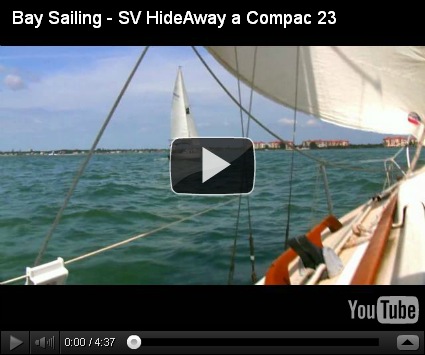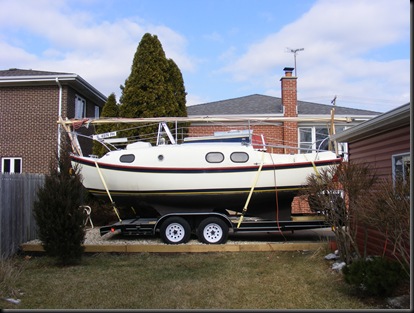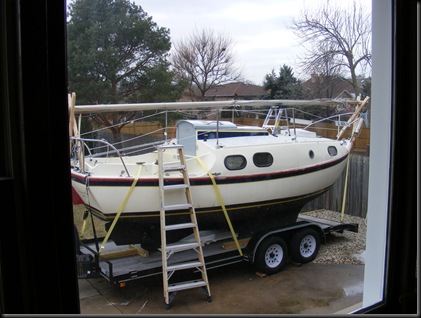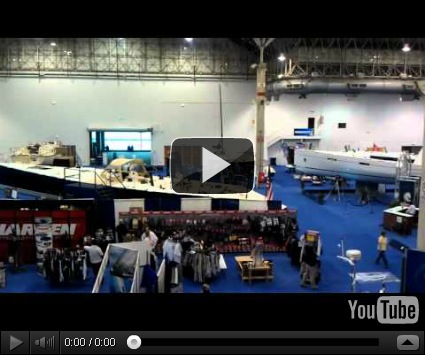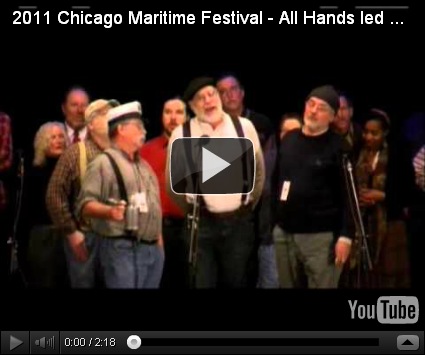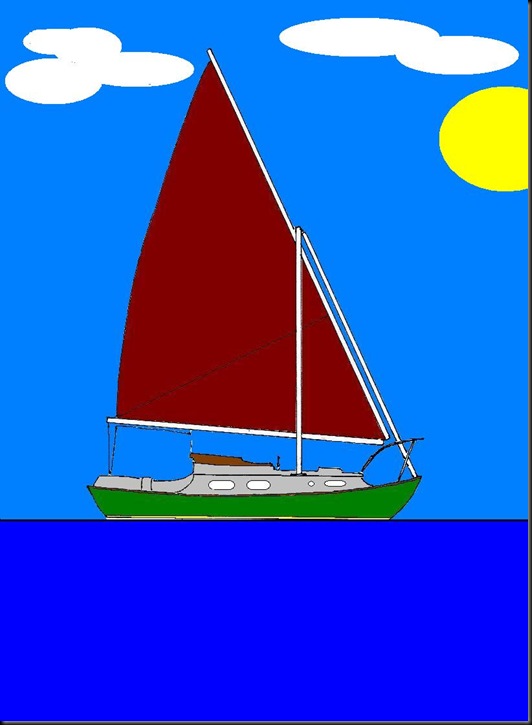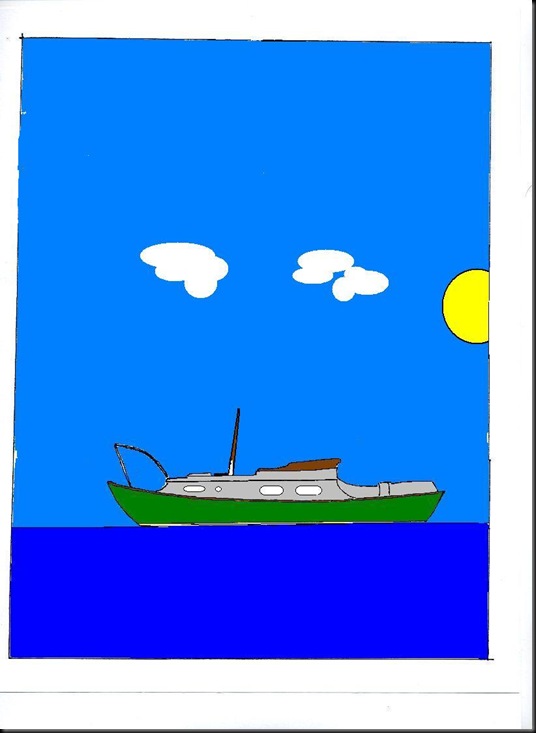By: Dennis A. Rayner – Originally Published in Twin-Keeler Newsletter, Summer, 1999 (Paper-Edition) – Adopted by: Kenneth Butterly
How We Designed The Westerly
Customers’ Needs – based on experience – came first
| In this design we have done our best to get away from the normal appearance of a plastic boat. Two heavy teak rubbing strips on each side go along way towards achieving this aim. The decks, after special preparation, are painted with International non-slip deck paint. The toe rails, the cabin trunk and the cockpit are of teak. We believe that in Westerly we have made the best possible use of old |
and new materials, and a really shipshape appearance is the result.

| Westerly is a twin-keeled sloop, with full hydrofoil sectioned keels toed-in 2 degrees. The twin keels and the skeg form a three-point landing so that she always settles easily when she dries out or is put on a trailer. The heavy mahogany skeg on which the rudder is hung is far enough away from the keels to avoid hydrodynamic interference between one keel appendage and another, The rudder blade is turned well up to avoid damage when grounding. |
The twin-keel design, with the ballast weights on the keels, ensures that Westerly makes very little leeway; also, it makes her remarkably stable. The hydrofoil acts in the same way as an airplane wing; it develops “lift” towards the curved surface, and this produces a thrust to windward. On the wind, Westerly’s performance is a great deal better than many keel boats, and when running, the twin-keels and long skeg hold the ship to her course; she always feels even larger than she really is. Her great stability is a result of the high ballast/weight ratio attained by the use of glass fibre construction. In the case of Westerly, this ratio is 42 per cent. This should compare with the ration of most wooden cruising yachts which is more generally in the region of 33 per cent. Westerly will heave to and she is so well balanced that she can be handled under either mainsail or jib alone.
Built to Lloyd’s series production schedule
| Everything about the hull and decks is built under Lloyd’s supervision and to their approval. The much-prized certificate can only be obtained after Lloyd’s surveyor’s closest inspection of the factory and of the boat during its building. Each hull is supplied with a Lloyds Certificate. This will be found in the future to have a very large effect on the second-hand value of any plastic boat built since Lloyd’s introduced this extremely worthwhile standard. In the manufacture of plastic-reinforced laminates, the factory building itself, as well as the skill of the workmen, contribute to a satisfactory product. In our new building, thanks to cavity brick walls and an insulated |
roof, with fans and heaters which control both temperature and humidity, we achieve a standard of resin cure which cannot be improved upon by any other boat builder; for it is on the carefully controlled transformation of the wet mat into a solid laminate that success depends.
A good plastic laminate is stronger and lasts longer with less maintenance than any other boatbuilding material yet devised. The Royal Navy now use it for all boats under 32 feet long, and, at both the Hamburg and New York boat shows in 1963, more than fifty percent of the exhibits were classed as of glass fibre construction.
We are always pleased to show perspective purchasers round our plant, where visitors are very welcome to see full details of the construction of Westerly both in drawings and in fact.
Fire risk reduced to a minimum

| There is no greater fire risk with glass fibre than with wood (and wood itself, when it has been built into a hull, is not easy to ignite). Fire at sea is neither caused nor prevented by the structure of the ship. It comes from what is carried in her and is nearly always the result of bad storage or faulty handling of inflammable liquids or gas. There is no greater fire risk with glass fibre than with wood (and wood itself, when it has been built into a hull, is not easy to ignite). |
Fire at sea is neither caused nor prevented by the structure of the ship. It comes from what is carried in her and is nearly always the result of bad storage or faulty handling of inflammable liquids or gas.
We as designers, cannot prevent mistakes at sea, but we can at least build our boats with special and adequate compartments for the two most dangerous liquids – petrol and bottled gas.
In Westerly we have provided safe storage in a way which we do not think has ever been done before in a boat of this size and price. Two separate watertight and vented spaces have been built into the stern. One of these will hold two gas bottles and the other a five-gallon petrol tank. The floors of both compartments slope aft and have open drains through the counter so that any spillage or leakage can immediately escape outboard. There is a great reduction in the fire hazard with this arrangement, which, in our opinion, should be obligatory on all cabin cruisers.
Economy
It is now generally recognized that boats of glass fibre construction are more economical to maintain than those built of any other material, both in ease of maintenance and in freedom from large repairs. Two people working for two weekends should be able to complete with ease the annual repaint and revarnish of the exterior.
(Editors Note: Sailors are still asking the same question.)
So much for the short-term view, but real economy should be considered over the normal useful life of any product. In the course of years many wooden and steel boats develop defects which call for heavy expenditure if their fabric is to be kept in perfect condition.
The US Customs Authority has recently completed a ten-year trial and has reported exhaustively on three boats built of glass fibre to the same common design as their boats with wooden and steel hulls. At the end of the ten-year period, the glass fibre hulls, tested scientifically showed no significant deterioration and carefully kept cost figures proved the remarkable economy in maintenance of the laminated plastic construction. The maintenance costs of the three boats examined were in every case less than one fifth of the cost of wooden or steel hulls in comparable service.
In other words, glass fibre can offer, over the years, an 80 percent reduction in maintenance cost.
Design for spaciousness
The feeling of space in Westerly’s cabin is a continual surprise to visitors. In this boat, the space taken up by each item has been so carefully regulated by experienced designed that the cabin feels even bigger than it really is. There are over 64 cubic feet of deep and easily reached lockers in the cabin furniture, besides four drawers, pan locker, galley, sink, cupboard and adequate
| hanging space. Our drawings give an overall impression of the lay-out and appearance of the cabin, but only a visit can really give an idea of the comfort aboard. Westerly has two 6 feet 6 inch berths and two 6 feet 3 inch forward berths which can be made into a double by inserting an additional mattress between them. If required the forward |
compartment can be made into a separate cabin, ensuring privacy.
| A marine-type lavatory is fitted in the forward cabin, and a double-burner cooker and sink amidships. In the cabin, the ship’s side is paneled in foam rubber and Vynide to match the cushions. This keeps the cabin cool in the summer and warm at the beginning and end of the season. |
In really cold weather, the cabin can be warmed by using the Calor-gas operated cabin heater which we have designed especially for use in our boats.
The cockpit
The cockpit is self-draining, with sea-cocks fitted to both drains. All the woodwork, seats and floor are of African teak. The seat backrest is deep and set at a comfortable angle against which to lean. A lifting tiller is standard equipment and greatly increases the effective size of the cockpit.
Advantages of the outboard engine

| Now that outboard engines are so very reliable and those with rubber mountings so quiet, there are great advantages in adopting this type of engine for auxiliary yachts of medium tonnage. After all, it is not only the machinery of an inboard engine that |
takes up space; the stowage capacity of every compartment through which exhaust or petrol pipes lead is also reduced in some measure.
Again, it is not merely in the context of space that the outboard scores. For sailing or at moorings, the propeller is lifted clear of the water. There can be no drag from an outboard. Westerly has been designed to carry an outboard, and has a well into which the engine-head may be tipped when not in use. The engine can be left locked on the counter throughout the year. Another material point: the very best outboard is a great deal cheaper than the fitted cost of even the cheapest inboard engine.
Choice of Rigs
| The hull will take either a Gunter or the Bermudan rig with equal facility; both give very much the same performance. The main advantage of the Gunter rig, in “family” sailing, is the ease in which it can be reefed without leaving the cockpit. In this rig, all the halyards lead aft to pinrails within reach of the helmsman. This is a big point for the man who may be at sea with his wife and children for crew. |
|

|
| We feel that the masthead Bermudan rig demands a stronger crew to handle the big working jib which is so much part and parcel of this rig; while in some peoples eyes the longer mast of this rig will give the boat a better look when at anchor than the shorter Gunter mast. So we think this choice is a matter for the individual, who will know the strength of his normal crew. |
Trailing
A trailer not only enables you to visit new cruising grounds for holidays without fear that bad weather will prevent your return to base – it also allows you to take your boat home for the winter. The small amount of servicing required by a glass fibre Westerly makes this a reasonable proposition even for a busy executive.
It is not necessary to have a special towing vehicle. When on a trailer designed by us for your boat, a Westerly will trail easily behind an four-geared car of over 1800CC (an automatic gear change seems to make no difference). Indeed, cars of as low a capacity as 1500cc have towed greater weights over selected routs without damage.
| Note: For more information on Commander Dennis A. Rayner I recommend you visit: So who was Cmdr. Denys A. Rayner and why the Blog? And: Wikipedia. |


